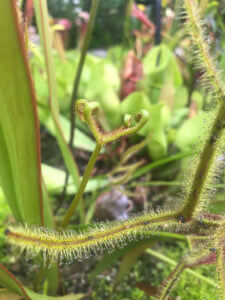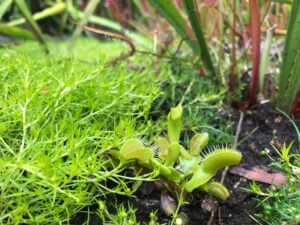Captivating Carnivorous Plants

Erin Aguiar
Horticulture Director
Precocious pitcher plants, seductive sundews and the vivacious, yet vicious Venus fly traps use their alluring bodies to entice their naive guests into a romantic dinner for two. But there’ll be no walk along the beach after this malicious meal. For the carnivorous plant, its date is the main course in this tale of summer love. These carnivorous plants have broken out of their winter dormancy and are ready for the summer sun. They grow in bog conditions of moist soil and pure rainwater and soak up hot, sunny locations. They will charm you with bright colors and striking patterns, resprouting and returning every summer. Not to worry, this summer fling won’t break your heart.
The players in this romantic drama have all adapted individually to lure, trap and digest insects and other critters in their own unique way. The American pitcher plant, Sarracenia, grows tall with long, slender tubes. Insects are attracted to the color and scent and by the nectar-like secretion on the lip of the pitcher. The insects slip into the tube, guided by angled hairs, as the modified leaves secrete digestive enzymes to consume their prey.


Sundews, in the Drosera genus, are the delicate sweethearts in the carnivorous world. The arching tendrils secrete sticky mucilage that glistens like tiny jewels in the sun. Small-winged insects get caught and struggle as the alluring coils tighten around their bodies and slowly digest them with specialized enzymes.
The infamous Venus fly trap’s name refers to Venus, the Roman goddess of love. The botanical name, Dionaea “daughter of Dione,” refers to Venus’ Greek counterpart, the goddess Aphrodite. The concave clamshell leaves lay open and silently await their prey. Small ants and winged insects are enticed by the sweet nectar produced on the rim of the mouth. As the insect passes over the large teeth to feed, it touches small hairs, stimulating the mouth to close. An electrical current signals the concave trap to reverse itself forcing the teeth to intertwine.


Like a classic summer fling, these marsh plants can be enjoyed during the warmer seasons before they go dormant for the winter. Have an appetite for rare and unusual plants then make sure to visit Sherman Library & Gardens’ Carnivorous Bog.

